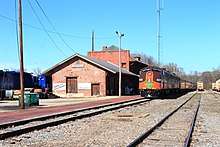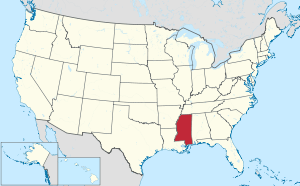Grenada County, Mississippi
Grenada County is a county located in the U.S. state of Mississippi. As of the 2010 census, the population was 21,906.[1] Its county seat is Grenada.[2] The county was named for the province of Granada in southern Spain but spelled inaccurately.[3] Its western half is part of the Mississippi Delta. Cotton cultivation was important to its economy well into the 20th century.
Grenada County | |
|---|---|

Illinois Central Depot now used by Grenada Railway. | |
 Location within the U.S. state of Mississippi | |
 Mississippi's location within the U.S. | |
| Coordinates: 33°46′N 89°48′W | |
| Country | |
| State | |
| Founded | 1870 |
| Named for | Granada |
| Seat | Grenada |
| Largest city | Grenada |
| Area | |
| • Total | 449 sq mi (1,160 km2) |
| • Land | 422 sq mi (1,090 km2) |
| • Water | 27 sq mi (70 km2) 6.1% |
| Population (2010) | |
| • Total | 21,906 |
| • Estimate (2018) | 21,055 |
| • Density | 49/sq mi (19/km2) |
| Time zone | UTC−6 (Central) |
| • Summer (DST) | UTC−5 (CDT) |
| Congressional district | 2nd |
The Grenada, MS Micropolitan Statistical Area includes all of Grenada County.
Geography
According to the U.S. Census Bureau, the county has a total area of 449 square miles (1,160 km2), of which 422 square miles (1,090 km2) is land and 27 square miles (70 km2) (6.1%) is water.[4]
Major highways
Adjacent counties
- Yalobusha County (north)
- Calhoun County (east)
- Webster County (southeast)
- Montgomery County (south)
- Carroll County (south)
- Leflore County (west)
- Tallahatchie County (northwest)
National protected area
Demographics
| Historical population | |||
|---|---|---|---|
| Census | Pop. | %± | |
| 1870 | 10,751 | — | |
| 1880 | 12,071 | 12.3% | |
| 1890 | 14,974 | 24.0% | |
| 1900 | 14,112 | −5.8% | |
| 1910 | 15,727 | 11.4% | |
| 1920 | 13,607 | −13.5% | |
| 1930 | 16,802 | 23.5% | |
| 1940 | 19,052 | 13.4% | |
| 1950 | 18,830 | −1.2% | |
| 1960 | 18,409 | −2.2% | |
| 1970 | 19,854 | 7.8% | |
| 1980 | 21,043 | 6.0% | |
| 1990 | 21,555 | 2.4% | |
| 2000 | 23,263 | 7.9% | |
| 2010 | 21,906 | −5.8% | |
| Est. 2018 | 21,055 | [5] | −3.9% |
| U.S. Decennial Census[6] 1790-1960[7] 1900-1990[8] 1990-2000[9] 2010-2013[1] | |||
As of the 2010 United States Census, there were 21,906 people living in the county. 56.9% were White, 41.7% Black or African American, 0.3% Asian, 0.2% Native American, 0.2% of some other race and 0.8% of two or more races. 0.9% were Hispanic or Latino (of any race).
As of the census[10] of 2000, there were 23,263 people, 8,820 households, and 6,297 families living in the county. The population density was 55 people per square mile (21/km²). There were 9,973 housing units at an average density of 24 per square mile (9/km²). The racial makeup of the county was 57.92% White, 40.93% Black or African American, 0.14% Native American, 0.34% Asian, 0.02% Pacific Islander, 0.13% from other races, and 0.52% from two or more races. 0.62% of the population were Hispanic or Latino of any race.
There were 8,820 households out of which 33.90% had children under the age of 18 living with them, 48.90% were married couples living together, 18.60% had a female householder with no husband present, and 28.60% were non-families. 25.30% of all households were made up of individuals and 10.60% had someone living alone who was 65 years of age or older. The average household size was 2.58 and the average family size was 3.09.
In the county, the population was spread out with 27.20% under the age of 18, 9.00% from 18 to 24, 27.50% from 25 to 44, 22.00% from 45 to 64, and 14.40% who were 65 years of age or older. The median age was 36 years. For every 100 females there were 87.80 males. For every 100 females age 18 and over, there were 83.90 males.
The median income for a household in the county was $27,385, and the median income for a family was $33,115. Males had a median income of $28,969 versus $21,567 for females. The per capita income for the county was $13,786. About 17.60% of families and 20.90% of the population were below the poverty line, including 26.30% of those under age 18 and 26.40% of those age 65 or over.
Education
Grenada School District is the public school system.
Politics
| Year | Republican | Democratic | Third parties |
|---|---|---|---|
| 2016 | 56.8% 5,970 | 42.1% 4,424 | 1.1% 119 |
| 2012 | 52.8% 5,986 | 46.7% 5,288 | 0.5% 61 |
| 2008 | 55.1% 6,234 | 44.4% 5,029 | 0.5% 58 |
| 2004 | 58.1% 5,872 | 41.3% 4,180 | 0.6% 59 |
| 2000 | 54.7% 5,129 | 44.4% 4,163 | 1.0% 93 |
| 1996 | 47.9% 4,527 | 46.6% 4,402 | 5.6% 526 |
| 1992 | 49.3% 4,721 | 43.9% 4,203 | 6.7% 644 |
| 1988 | 59.1% 5,352 | 40.7% 3,683 | 0.2% 21 |
| 1984 | 60.8% 5,181 | 39.0% 3,325 | 0.2% 15 |
| 1980 | 48.1% 3,993 | 50.4% 4,182 | 1.5% 125 |
| 1976 | 50.8% 3,569 | 46.5% 3,263 | 2.7% 188 |
| 1972 | 75.1% 4,800 | 23.0% 1,471 | 1.9% 121 |
| 1968 | 10.1% 718 | 28.9% 2,050 | 61.0% 4,335 |
| 1964 | 95.9% 3,648 | 4.1% 155 | |
| 1960 | 29.1% 682 | 22.6% 529 | 48.3% 1,132 |
| 1956 | 18.6% 407 | 43.4% 949 | 38.0% 832 |
| 1952 | 46.0% 1,000 | 54.0% 1,174 | |
| 1948 | 1.7% 26 | 7.1% 109 | 91.2% 1,406 |
| 1944 | 7.9% 117 | 92.2% 1,373 | |
| 1940 | 4.4% 62 | 95.0% 1,354 | 0.6% 9 |
| 1936 | 1.0% 13 | 99.0% 1,245 | |
| 1932 | 1.0% 11 | 99.0% 1,101 | |
| 1928 | 3.4% 40 | 96.7% 1,155 | |
| 1924 | 1.8% 17 | 98.2% 933 | |
| 1920 | 2.2% 12 | 96.4% 533 | 1.5% 8 |
| 1916 | 4.1% 28 | 94.9% 649 | 1.0% 7 |
| 1912 | 0.6% 3 | 94.8% 469 | 4.6% 23 |
External links
References
- "State & County QuickFacts". United States Census Bureau. Archived from the original on June 7, 2011. Retrieved September 3, 2013.
- "Find a County". National Association of Counties. Archived from the original on 2011-05-31. Retrieved 2011-06-07.
- Gannett, Henry (1905). The Origin of Certain Place Names in the United States. Govt. Print. Off. pp. 144.
- "2010 Census Gazetteer Files". United States Census Bureau. August 22, 2012. Archived from the original on September 28, 2013. Retrieved November 3, 2014.
- "Population and Housing Unit Estimates". Retrieved November 11, 2019.
- "U.S. Decennial Census". United States Census Bureau. Retrieved November 3, 2014.
- "Historical Census Browser". University of Virginia Library. Retrieved November 3, 2014.
- "Population of Counties by Decennial Census: 1900 to 1990". United States Census Bureau. Retrieved November 3, 2014.
- "Census 2000 PHC-T-4. Ranking Tables for Counties: 1990 and 2000" (PDF). United States Census Bureau. Retrieved November 3, 2014.
- "U.S. Census website". United States Census Bureau. Retrieved 2008-01-31.
- Leip, David. "Dave Leip's Atlas of U.S. Presidential Elections". uselectionatlas.org. Retrieved 2018-03-04.